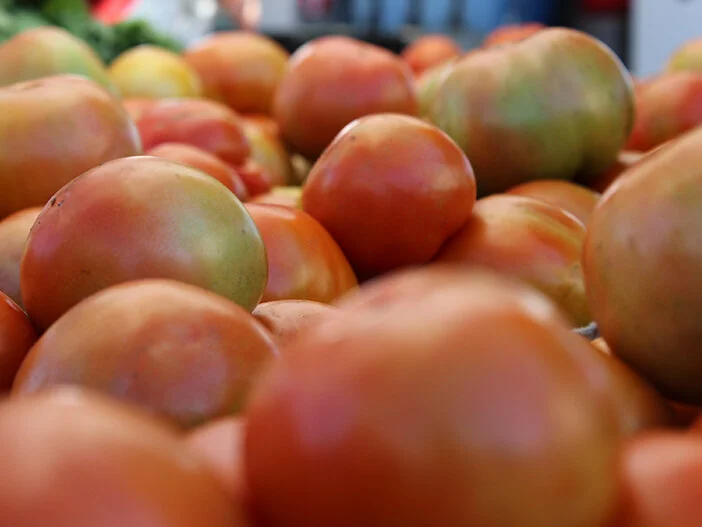HISTORY
The first tomatoes can be traced to the South American Andes Mountains where they grew wild as cherry-sized berries.
Priests following the Spanish conquistadors most likely sent the first seeds to Spain in the early 1500s. The fruit gained little attention in Spain, but soon traveled to Italy—a country that embraced tomatoes with great passion and developed numerous recipes which are still popular today.
By the mid-16th century, tomatoes made their return to America via English colonists. They did not become an important part of the American diet, however, until after World War I.
PRODUCTION
Tomato plants are planted in the field as seeds or as young plants called seedlings.
If sowing seeds directly into the ground, the farmer sows seeds in late January or early February.
If planting by seedling, plants are grown in greenhouses until they are hardy enough to be planted outside in the spring.
Tomatoes are ready for harvest between early July and mid-October.
To avoid the daytime heat, tomato growers often harvest the crop after sunset. Mechanical harvesters move through fields picking the entire tomato plant and shaking the tomatoes off the vine. Specially designed electronic sensors on the harvesters sort the ripe, red tomatoes from the vine and transfer them into a gondola pulled by a tractor following alongside.
Then, the tomatoes are stored for certain amounts of time and temperatures depending on the stage of ripeness.
NUTRITION
Tomato is a juicy, nutritious fruit commonly eaten as a vegetable.
It is another wonderful gift of the Mayans to the world. This humble vegetable of Central America has seized the attention of millions of health seekers for its incredible nutritional properties. Interestingly, it has more health-benefiting compounds than some popular fruits, even apples.
Tomatoes are a naturally low-calorie food. Lycopene, the ingredient that makes tomatoes red, is an antioxidant that blocks cellular damage and is highly effective in preventing cancers.
Tomatoes do not lose their health benefits as they are processed and cooked. In fact, the lycopene in cooked and processed tomatoes (sauces, pastes, salsas and canned tomatoes) is more easily absorbed than fresh tomatoes. This fact, along with their popularity, makes tomatoes a leading nutritional source in the American diet.
VARIETIES
There are more than 2,750 genetic varieties of fresh market and processing tomatoes at the Tomato Genetics Stock Center at the University of California, Davis. These varieties have been developed to suit the various growing conditions around the state, taking into account soil type, climate and disease.
FUN FACTS
Tomatoes have largely impacted American eating habits; Americans consume more than 12 million tons of tomatoes each year.
The first cultivated tomatoes were yellow and cherry-sized, earning them the name golden apples. They were considered poisonous but appreciated for their beauty.
ANATOMY
TERMS TO KNOW
Cultivate - prepare and use land for crops or gardening
Gondola - a bin pulled by a tractor that catches tomatoes being harvested
Hardy - capable of enduring difficult conditions
Seedling - seeds or young plants
Sowing - planting the seeds of a plant or crop
RECIPE
Tomato Aspic Salad
Ingredients:
3-ounce package strawberry Jello
2 cups tomato juice
1 tablespoon lemon juice or vinegar
1 tablespoon prepared horseradish
1 tablespoon finely chopped onion
1 heaping tablespoon pickle relish
½ cup finely chopped celery
½ cup chopped black olives
Directions:
In medium saucepan, combine tomato juice and Jello.
Cook over medium heat, stirring constantly, to dissolve the Jello.
Cool until partially set.
Add lemon juice, horseradish, onion, relish, celery and olives, mixing will.
Pour into an oiled 8-inch square mold.
Place in refrigerator to set.
Serve on endive or lettuce leaves.
Foods à la Louisiane—a cookbook by the Louisiana Farm Bureau Women
Submitted by Lillian Maberry of Hilger, Montana
COLORING PAGE
Select the image below to download, print and color this fact sheet. Fit-to-page printing option recommended. See more commodity coloring pages!
MAKE & TAKES
Turning Tomato
LESSON PLANS
Grades K-2
Eat ‘Em Up
Eating Plants
Fruit and Vegetable Bingo
A Garden Plot: The Tale of Peter Rabbit
Homegrown in Your State: Fruits and Vegetables
Plant Tops and Bottoms
Tomato Trivia
Who Grew My Soup?
Grades 3-5
FoodMASTER: Vegetables
Give Me Five!
My Life as a Fruit or Vegetable
Nutritional Value of Fresh Produce
Pizza Time!
Who Grew My Soup?
Grades 6-8
Aeroponic Engineering and Vertical Farming
Cruisin’ for a Bruisin’ Food Packaging Specialist
Grades 9-12
Aeroponic Engineering and Vertical Farming
Fruits and Vegetables: The Right Pick for Vitamins and Minerals


